As the debate rages about potential re-engining of the current single-aisle offerings from Airbus and Boeing, close scrutiny of 2009's deliveries shows why it is vital for Pratt & Whitney to cash in on its apparent lead with the geared turbofan.
A detailed examination of Airbus and Boeing's 2009 shipments by Flightglobal's Insight analytical arm using data from our ACAS database reveals that while GE and its joint venture CFM International remain the dominant market players, P&W's participation has slipped to an all-time low (Graph 1). The Connecticut-based engine maker powered just 1% of all mainline jets delivered last year, down from 3% in 2008. A decade ago, P&W powered around 9% of the airliners delivered.
Just 10 of the 979 Airbus and Boeing airliners delivered last year were powered by P&W's "dependable engines" - four of the last eight Boeing 747-400s built and six Airbus A330s. With the old Jumbo now out of production, and almost all 777 output being of the GE90-115B powered -200LR/300ER/777F flavour, P&W has just one solid commercial application for its big fan engine - the A330 (Graph 2/3).
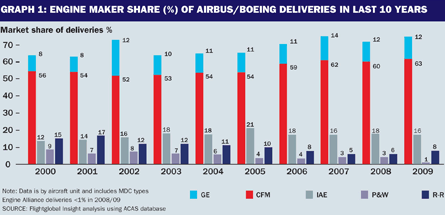 |
|---|
The prospect of additional PW6000-powered A318s being sold appears dim, with just one operator of that version - LAN Airlines - and Airbus's backlog for its smallest jet almost into single figures.
"P&W also needs to work hard to keep its powerplant status on the KC-767 [tanker variant of Boeing's 767 airliner]," says Richard Aboulafia, who is vice-president analysis at US consultancy Teal Group. "It looks like that platform will be the victor in the USAF's KC-X competition, but it isn't really clear what's happening on the engine front."
The position of P&W's International Aero Engines venture with Rolls-Royce is also on the slide, with the engine maker - which has one product, the V2500, with just one application, the Airbus A320 family - powering 16% of all airliner deliveries in 2009, down two percentage points from 18% the year before.
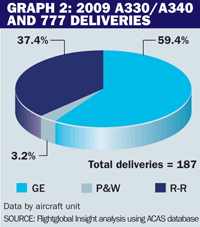 |
|---|
Although IAE is still providing strong competition for CFM on the Airbus narrowbodies, the company has recently struggled to match the market success of the middle of the last decade, when it was able to almost match its rival in deliveries. In 2009 CFM again took the lion's share of A320 family deliveries, powering 61% of shipments (Graph 4).
P&W's inevitable market share decline emphasises why it is throwing so much effort into making the GTF a success, and has targeted one or both of the current single-aisles as a lifeboat for its commercial engines business. Although it has landed sole-supplier deals with the GTF for two new small airliners - the Bombardier CSeries airliner and Mitsubishi MRJ regional jet, it knows that real long-term success should be all but guaranteed if it can be selected to power a rejuvenated A320 or 737 family.
The engine maker had thought it had the answer 10 years ago with the PW6000 (as did Airbus), but this plan came undone when the engine failed to live up to performance promises and had to be redesigned, resulting in a delay from which it never recovered. Connecticut is more than aware that it cannot afford a repeat.
Aboulafia says that while it looks as though the GTF has "a strong shot" at being adopted by Airbus for an A320 family re-engining, "Pratt will need a very compelling technical and economic case to get on the next 737. GE will use all of its industrial and financial muscle to keep the 737 a sole-source product. Still, there's a lot of risk in its Leap X advanced turbofan, and we don't know if it has the same potential cost savings as GTF."
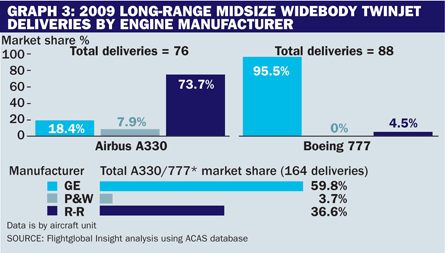 |
|---|
As P&W's share declined, R-R saw a gain in 2009, thanks largely to its success on the A330. The gradual ramp-up of Trent-powered A380 deliveries partially offset the poor showing of the A340-500/600, which appears to be in the twilight of its production life. From next year, R-R will also begin to feel the benefit of 787 production, as the UK engine maker is lead powerplant supplier on the Dreamliner.
For GE it was business as usual last year. The company is now the established market leader in big-fan engines, with its share stabilising at 12% of all deliveries, while its CFM arm is consistently powering over 60% of airliner shipments. This gave the two partners an almost unprecedented 75% share of deliveries in 2009.
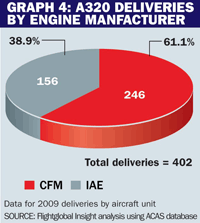 |
|---|
GE and CFM are now established as the lead suppliers to Airbus, powering just over half of all its deliveries (Graph 5). Unsurprisingly, given their exclusive status on the 737 and later 777 models, they dominate at Boeing. Last year the GE/CFM share of Boeing deliveries reached a new high of 98%, having risen steadily from around 70% at the start of the decade.
"The Boeing/GE alliance seems to work very well for the two companies," Aboulafia says. "It doesn't seem to have created any problems in terms of alienating customers - 777-300ER numbers have long since eclipsed 777-200ER sales, even though customers no longer have an engine choice."
Although the rival engine suppliers have been marginalised with the demise of the 777-200ER - added to which is the fact that the new 747-8 is exclusively GE-powered - the arrival of the 787 should ensure that GE/CFM's Boeing share does not climb any higher, as deliveries of R-R Trent-powered Dreamliners are due to start by year-end.
CFM's comfortable position on the 737 has not prevented it pursuing an aggressive development programme, with the new "Evolution" iteration of the CFM56-7B engine due to debut next year. Beyond that, CFM is confident it can build on its success at Comac, which has selected the Leap X to power its C919 twinjet, and is in discussions to offer the engine on the A320 and 737 for proposed re-engined models.
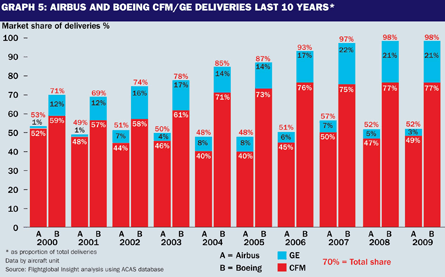 |
|---|
As illustrated in Table 1, Airbus and Boeing's top five customers in terms of deliveries last year accounted for one-fifth of all shipments. Two of the top five are European low-cost carriers - with Ryanair being the single biggest recipient of aircraft last year, having taken 54 737-800s.
While the Gulf airlines do not figure in the top five delivery rankings, three customers from the region - Dubai lessor DAE, along with Qatar Airways and Emirates - appear in Table 2, which shows the top 10 by order backlog (they are three of the top five and account for one-third of the entire top 10's total orders). China's central purchasing arm CASGC is top, but significantly the two heavyweight US lessors - GECAS and International Lease Finance - have dropped to eighth and 10th place having figured much higher up the rankings in our previous surveys.
 |
|---|
Aboulafia says that aside from the financial trouble that some lessors' parents have run into in the banking crisis, there is also the issue that their portfolio of jets has been "badly beaten up" as a result of ongoing high output rates. "Record production and terrible traffic equals declining lease rates and asset values, and therefore most lessors are effectively out of the market for new jets," he says.
The split by airframer (Table 3) shows Airbus's greater reliance on the Gulf and Asia - four of its top five are from these regions - whereas Boeing has a more even spread that also comprises European and US airlines.
Data from ACAS reveals that European airlines were the single biggest recipients of new airliners last year (Graph 6) - an achievement driven by the continued hunger of the region's low-cost carriers. Boeing has a big part to play here with Ryanair as an exclusive customer and the region accounted for just over one-fifth of its 2009 deliveries. Unsurprisingly, Europe was Airbus's most important market last year, accounting for 38% of its deliveries (Graph 7).
 |
|---|
Similarly, North America was Boeing's lead sector with one-third of its total deliveries. Airbus has struggled to match Boeing's success in Europe, with its rival's home patch only accounting for 19% of its deliveries. The rivals were fairly evenly matched in the other markets.
The European airframer continues to be more reliant than Boeing on narrowbodies, with its single-aisle family representing 81% of its 2009 deliveries, against 77% for its rival (Graph 8). Both airframers should see the ratio shifting towards widebodies from next year as the delayed ramp-up of A380 and 787 production finally begins to take affect.
"Airbus will become even more dependent on narrowbody output for revenue as the A340 dies this year, as the A380 fails to ramp up in more than token numbers, and as the A330 is gradually displaced by the 787," says Aboulafia. "Basically, the 787 delays were very good for Airbus because that translated into a few great years for the A330. But this basically postponed an inevitable day of reckoning."
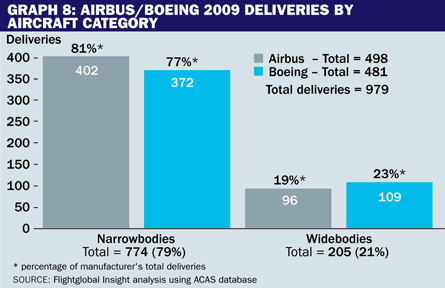 |
|---|
Aboulafia believes that this combined with Boeing's unwillingness to cede market share in the narrowbody sector, has been partly why single-aisle production has hit absolute and relative highs. "Typically, single-aisle jets are 45% of the jet airliner market by value. Over the past few years, that has risen to 55%, and in a time of record deliveries," he says. "There is clearly oversupply and overcapacity in exactly the segment that Airbus is dependent upon for revenue."
Source: Flight International



















